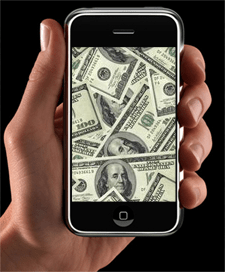Apple’s App Store and Goole Play on Android continue to set the pace for the overall performance and fortunes of mobile apps worldwide, while BlackBerry and Microsoft’s Windows Phone remain “distant challengers.” Figures out today from Canalys note that in Q1 2013, the four top app stores worldwide collectively accounted for 13.4 billion downloads, with $2.2 billion in paid app sales, in-app purchases and subscriptions. But while Google has long passed Apple as the biggest smartphone platform worldwide, Apple is still the undisputed leader when it comes to monetizing: Google Play accounted for 51% of all downloads (6.8 billion), but Apple’s App Store for 74% of all revenues ($1.6 billion).
In terms of downloads, Canalys says that Apple is not too far behind Google, with close to 40% of all downloads worldwide, while BlackBerry and Microsoft still hold single-digit percentage shares. Tim Shepherd, a senior analyst at Canalys, tells TechCrunch that he expects to see the gap between Google and Apple grow as Android retains its dominant position in the smart phone market globally.
In revenue numbers, however, Google has a lot of catching up to do. Compared to Apple’s 74%, Google is “close to 20%,” he says. The others are in single digits.
The figures represent 11% growth compared to Q4 in terms of download volumes, and about 9% growth in terms of sales. In terms of the biggest markets, app store revenues in North America were up by 8% and downloads 6%, and in Western Europe, revenues were up 8% and downloads 10%.
The concentration of activity on Apple and Google’s platforms show that while it continues to be a challenge for smaller players to break the hegemony that is Samsung/Android and Apple on handset sales, the same goes in content. “Upping their respective installed base of users is critical if BlackBerry or Microsoft are to close these gaps,” says Shepherd.
This may not come as good news to challengers, who are putting a lot of effort into building up their app stores as a way of making their hardware more attractive. That has included, in some cases, help to developers to make sure that key apps get into the smaller markets, and campaigns to bring certain high profile apps to new platforms. (One of the most notable has been Nokia’s efforts to get Instagram to Windows Phone.)
Still, the discrepancies of app numbers are one kind of indication about where developers are choosing to focus their energies. While Apple and Google are well over 500,000 apps each in their stores, BlackBerry currently has around 100,000.
The other important point of so many apps is that it continues to be a counterbalance to more general wider web use. Whether or not mobile web represents a more open and encompassing opportunity, the fact that apps continue to persist as a primary way of accessing things on mobile devices continues to have an impact on how all developers will have to position their work in the future. On touchscreens, it seems that icons as initial points of entry, and experiences that make full use of the hardware, will continue to persist as must-haves for consumers.
Despite the challenges, and the not very encouraging numbers, Canalys still sees an opportunity for BlackBerry and Microsoft to improve their respective positions.
“Apple’s App Store and Google Play remain the heavyweights in the app store world,” writes Shepherd. “In comparison, BlackBerry World and the Windows Phone Store remain distant challengers today, though they still should not be ignored.”
In Canalys’ view, once chance lies in how these new app stores tackle less mature markets where there is still growth to be found in countries like South Africa, Brazil and Indonesia.
